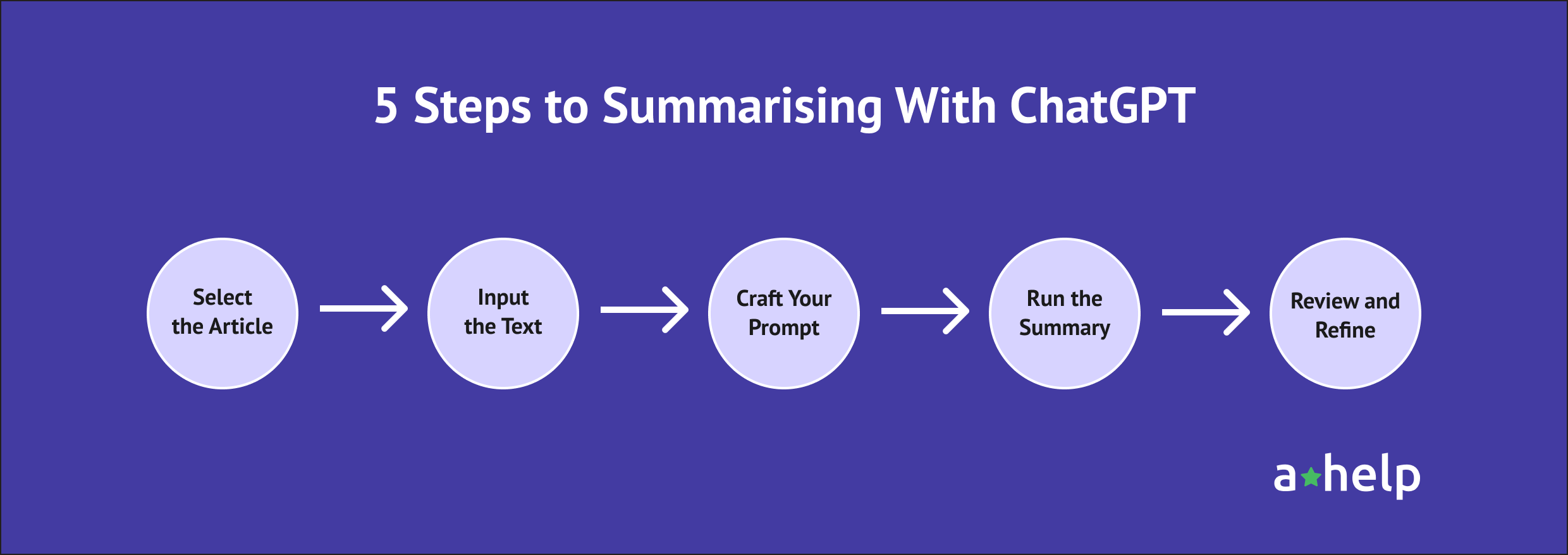We live in the fast-paced world of digital information, where the ability to quickly digest content is a necessity. Enter ChatGPT, the AI chatbot that’s changed the way we interact with text, and there’s no way in denying it. For students and professionals alike, learning how to get ChatGPT to summarize articles can be a game-changer and a shortcut to key insights without sacrificing depth or accuracy.

✅ AI Essay Writer ✅ AI Detector ✅ Plagchecker ✅ Paraphraser
✅ Summarizer ✅ Citation Generator
The Mechanics Behind Article Summarization
The process of summarizing an article by AI, such as ChatGPT, involves several steps, all rooted in advanced natural language processing (NLP) and understanding. Initially, the AI undergoes a text preprocessing phase where it cleans and prepares the data. This may involve removing special characters, correcting typos, and standardizing text formats. After this, the AI breaks down the text into smaller units called ‘tokens;, which can be words or phrases, in a process known as tokenization. This is necessary for understanding the structure and flow of the content.
Next, the AI uses NLP algorithms to identify the main ideas, key points, and critical information within the text, looking for patterns, keywords, and phrases that it recognizes as important. Once these key elements are identified, the AI extracts the relevant information, like sentences or phrases that best represent the core message of the article.

The extracted information is then condensed into a shorter form through techniques like paraphrasing and summarization, coming up with a coherent and concise summary. Finally, the AI performs post-processing to refine the whole text, which may include adjusting sentence structure, checking coherence, and fine-tuning the language to make the summary more readable (which is the whole point).
Throughout this entire process, the AI must maintain a balance between precision and brevity, so that the summary is accurate and captures the key points without distortion, while also being concise and removing any non-essential information. The effectiveness of the summarization depends on the sophistication of the algorithms and the quality of the input text.
Now, you can streamline the summarizing process with the help of AI: give a chance to our new AI Summary Generator and create first drafts in just a few seconds.
How to Get ChatGPT to Summarize an Article
Practice makes perfect, so we advise you to give it a try. To effectively use ChatGPT for summarizing an article, you can follow these steps:

- Select the Article: Begin by choosing an article that is well-structured and has clear main points. This will make it easier for ChatGPT to identify the key elements of the text and produce a good summary. Look for articles with distinct sections, headings, or an obvious thread of arguments.
- Input the Text: Once you have selected the article, copy the text and paste it into the ChatGPT interface. Be sure to include the entire article to get a thorough summary. If the article is too long, you might need to summarize it in sections. Yeah, we know it means more work, but this way the text will be much more organized.
- Craft Your Prompt: To get the best results, you need to provide ChatGPT with a clear and specific prompt. Tell the AI exactly what you want, such as the length of the summary or the aspects you want to focus on. For example, you could say, “Summarize this article in 200 words, focusing on the main arguments and conclusions.” The more precise your prompt, the more accurate and useful the summary will be!
- Run the Summary: After crafting your prompt, submit it to ChatGPT and let the AI work its woodoo magic. ChatGPT will analyze the text based on your instructions and generate a summary that captures the essence of the article. This process usually takes just a few seconds.
- Review and Refine: Once you have the summary, review it for accuracy and completeness, because a good proofreading never hurt nobody. Make sure it covers all the main points of the article and is free of errors. If you find any issues or if the summary misses important information, you can adjust your prompt and ask ChatGPT to try again.
You can effectively use ChatGPT to create concise and informative summaries of articles by following these steps, and save time and effort in digesting complex information.
Tips and Tricks for Getting Better Summaries
To improve the efficiency of ChatGPT when generating article summaries, you can also keep in mind these additional tips and tricks.

Break Down Complex Requests
If your article covers multiple topics, try asking for separate summaries for each section. This can help ChatGPT focus on specific areas without getting overwhelmed.
Example Prompt:
“Summarize the first section of this article in 100 words, focusing on the impact of technology on education.”
Why it works:
By specifying a particular section and topic, this prompt helps ChatGPT concentrate on a narrower scope, leading to a more detailed and relevant summary.
Highlight Key Elements
If you’re interested in specific elements like statistics, case studies, or quotes, mention that in your prompt.
Example Prompt:
“Provide a summary of this article, including all major statistics and their implications.”
Why it works:
This prompt directs ChatGPT to prioritize the inclusion of statistical data in the summary, ensuring that crucial quantitative information is not omitted.
Ask for Summaries in Points
Requesting a bullet-point summary can help you get a clearer, more organized overview.
Example Prompt:
“Create a bullet-point summary of this article, outlining the main arguments and key examples.”
Why it works:
Bullet points break down the information into digestible chunks, making it easier for ChatGPT to present a structured and concise summary.
Specify the Tone or Style
If you need the summary for a specific purpose, such as a presentation or report, you can ask ChatGPT to match the tone accordingly.
Example Prompt:
“Summarize this article in a formal tone, suitable for an academic report, focusing on the research methodology and findings.”
Why it works:
By specifying the tone and content focus, this prompt helps ChatGPT tailor the summary to fit the context of an academic report, ensuring it meets the expected standards.
What About the Limitations When Summarizing Articles with ChatGPT?
While ChatGPT is surely a helpful ally in case of article summarization, it’s important to acknowledge that it does have its limitations.

One common challenge is context loss, where summaries might overlook nuanced details or fail to capture the full context of the original article. This can lead to a summary that, while condensed, might miss important subtleties or fail to pass on the complete message.
Another obstacle is length constraints. Longer articles, with their multiple themes and complex arguments, might not be fully covered in a single summary. This can result in key points being left out, and lead to an incomplete overview of the article. Subjectivity and accuracy are also concerns when using AI for summarization. AI algorithms, including those powering ChatGPT, can sometimes introduce bias into the summaries they generate. This can be due to the training data used to develop the AI or the limitations of the algorithms themselves.
To overcome this, there are several strategies you can try. For long articles, breaking down the text and summarizing it section by section can keep all key points covered without overwhelming the AI. This approach allows for a more thorough and detailed summary of the entire article.
Cross-checking the summary against the original text is another step. This helps verify the accuracy of the summary, so that no critical information has been omitted or misrepresented. Adjusting your prompts can also make a significant difference. Try to experiment with different prompts, so that you can guide ChatGPT to focus on specific aspects of the article or to include details that might have been missed in previous summaries. This customization can help to get missing details or context and lead to a more accurate summary.
Here’s a table chart summarizing the main obstacles and how to overcome each of them:
| Obstacle | How to Overcome |
|---|---|
| 🧐 Context Loss | Break down the article into sections and summarize each part separately to guarantee all details are captured. |
| 🧑💻 Length Constraints | Summarize the article section by section to cover all key points without overwhelming the AI. |
| 🕵️ Bias and Accuracy | Cross-check the summary against the original text and adjust prompts to guide ChatGPT in capturing the full context. |
Conclusion
Using ChatGPT to create article summaries can be a very efficient way to process information quickly and effortlessly, and should be used correctly. While it’s important to be aware of its limitations, with the right approach and some practice, ChatGPT can become your go-to source for such tasks. Whether for academic research, content marketing, or personal learning, getting to know how to summarize with AI is a skill that promises to keep you ahead no matter what you do.
FAQ
Follow us on Reddit for more insights and updates.





Comments (0)
Welcome to A*Help comments!
We’re all about debate and discussion at A*Help.
We value the diverse opinions of users, so you may find points of view that you don’t agree with. And that’s cool. However, there are certain things we’re not OK with: attempts to manipulate our data in any way, for example, or the posting of discriminative, offensive, hateful, or disparaging material.